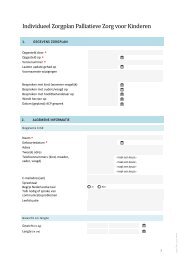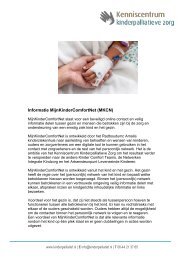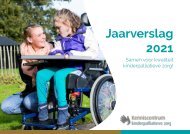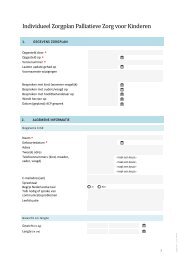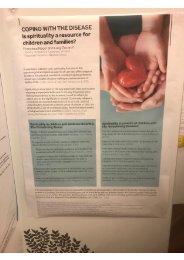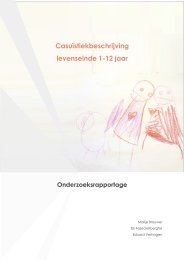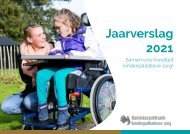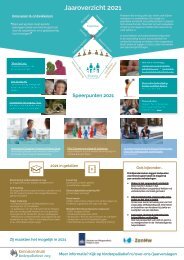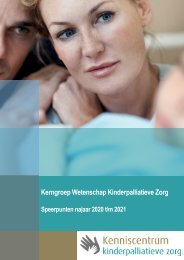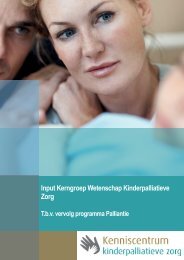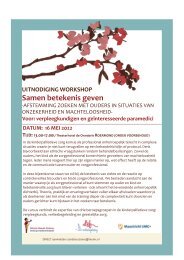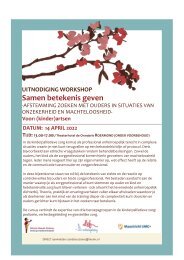EAPC Atlas of Palliative Care in Europe 2019
Conclusion: PC health policies developed in recent years have promoted vigorous development across Europe. Preliminary data on the integration of PC into different fields are encouraging though inequalities between countries and sub-regions persist. Further comparative analysis exploring factors leading to uneven progress may inform strategies to provide PC for all people in need. Per land is de stand van zaken van de (kinder)palliatieve zorg weergegeven.
Conclusion: PC health policies developed in recent years have promoted vigorous development across Europe. Preliminary data on the integration of PC into different fields are encouraging though inequalities between countries and sub-regions persist. Further comparative analysis exploring factors leading to uneven progress may inform strategies to provide PC for all people in need.
Per land is de stand van zaken van de (kinder)palliatieve zorg weergegeven.
You also want an ePaper? Increase the reach of your titles
YUMPU automatically turns print PDFs into web optimized ePapers that Google loves.
POPULATION AND METHODS<br />
Methods <strong>of</strong> the project<br />
B<br />
These <strong>in</strong>dicators were compiled <strong>in</strong> the Brief Manual on Health Indicators to Assess Global <strong>Palliative</strong> <strong>Care</strong> Development, which has<br />
been endorsed by other <strong>in</strong>ternational organizations promot<strong>in</strong>g palliative care (Arias-Casais, <strong>2019</strong>).<br />
Table. Indicators used <strong>in</strong> the <strong>EAPC</strong> <strong>Atlas</strong> <strong>of</strong> <strong>Palliative</strong> <strong>Care</strong> Development <strong>in</strong> <strong>Europe</strong> <strong>2019</strong>.<br />
Doma<strong>in</strong> Code Name<br />
policy P1 Designated human resource (labelled as unit, branch, department) <strong>in</strong> the M<strong>in</strong>istry <strong>of</strong> Health<br />
(or equivalent) responsible for palliative care<br />
P2<br />
P3<br />
P4<br />
P5<br />
P6<br />
Existence <strong>of</strong> a current national palliative care plan, programme, policy or strategy<br />
Existence <strong>of</strong> a specific PC national law<br />
Existence <strong>of</strong> national standards and norms for the provision <strong>of</strong> palliative care services<br />
Existence <strong>of</strong> systems <strong>of</strong> audit<strong>in</strong>g, quality evaluation, improvement or assurance for PC services<br />
Allocation <strong>of</strong> funds for palliative care activities <strong>in</strong> the national health budget by the M<strong>in</strong>istry<br />
<strong>of</strong> Health or equivalent government agency<br />
P7 Inclusion <strong>of</strong> PC services <strong>in</strong> the basic package <strong>of</strong> health services<br />
P8 Inclusion <strong>of</strong> PC <strong>in</strong> the list <strong>of</strong> health services provided at primary care level <strong>in</strong> the national health system<br />
EDUCATION E1 Existence <strong>of</strong> a process <strong>of</strong> <strong>of</strong>ficial specialisation <strong>in</strong> <strong>Palliative</strong> Medic<strong>in</strong>e for physicians, recognized by the<br />
competent authority<br />
E2 Medical schools <strong>in</strong>clud<strong>in</strong>g mandatory palliative care education <strong>in</strong> undergraduate curricula<br />
E3 Nurs<strong>in</strong>g schools <strong>in</strong>clud<strong>in</strong>g mandatory palliative care education <strong>in</strong> undergraduate curricula<br />
E4 Pr<strong>of</strong>essorship <strong>in</strong> PC <strong>in</strong> medical schools<br />
Use <strong>of</strong> medic<strong>in</strong>es M1 Opioid consumption –<strong>in</strong> morph<strong>in</strong>e equivalence (ME) exclud<strong>in</strong>g methadone- per capita as reported<br />
to the INCB (year)<br />
M2 General availability <strong>of</strong> immediate-release oral morph<strong>in</strong>e (liquid or tablet) at the primary care level<br />
M3 Requirement <strong>of</strong> specific licenses to prescribe opioids<br />
M4 Pr<strong>of</strong>essionals legally allowed to prescribe opioids<br />
SERVICE PROVISION S1 Number <strong>of</strong> specialised home palliative care teams (estimate)<br />
S2 Number <strong>of</strong> <strong>in</strong>patient palliative care units <strong>in</strong> hospitals (public and private) (estimate)<br />
S3 Number and type <strong>of</strong> palliative care programs for children (estimate)<br />
S4 Number <strong>of</strong> <strong>in</strong>patient hospices<br />
S5 Number <strong>of</strong> specialised hospital palliative care support teams<br />
S6 Number <strong>of</strong> specialised palliative care services <strong>in</strong> the country per population<br />
Pr<strong>of</strong>essional ACTIVITY V1 Existence <strong>of</strong> at least one national palliative care association<br />
V2 Existence <strong>of</strong> a national palliative care directory <strong>of</strong> services<br />
V3 Number <strong>of</strong> scientific articles on PC development <strong>in</strong> the past five years<br />
<strong>EAPC</strong> <strong>Atlas</strong> <strong>of</strong> <strong>Palliative</strong> <strong>Care</strong> <strong>in</strong> <strong>Europe</strong><br />
38




